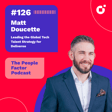
#121 - Peter van Kersen | Streamlining HR for Startups
Peter is a seasoned People/HR Leader with a track record of aiding startups in achieving sustainable and rapid growth. He emphasizes the significance of establishing a strong foundation, likening it to building a structure. Having contributed to the expansion of companies such as Catawiki, Delivery Hero, Glovo, REMY Robotics, and Docplanner, Peter excels in fostering empowering experiences and solid frameworks. His proficiencies encompass diverse areas like People analytics, Business unit management, Talent development, HR Operations, Digital Transformation, Performance management, Compensation & Benefits, and Leadership growth.
Shownotes
00:00 - The Challenge of Disconnected HR Systems
03:11 - Navigating HR Tools for Startups
05:58 - Data Flow and Workforce Planning
09:08 - Streamlining Data Collection for New Hires
12:02 - Integrating Systems for Efficient HR Operations
15:00 - Leveraging Data for People Analytics
18:02 - The Importance of Macro and Micro Data
20:59 - AI in Recruitment and Performance Management
24:00 - Building a Comprehensive Hiring Framework
27:00 - Connecting Startups with HR Solutions
Links
Peter Linkedin https://www.linkedin.com/in/petervankersen/
Thomas Linkedin: https://www.linkedin.com/in/thomas-kohler-pplwise/
Thomas e-mail: thomas@pplwise.com
pplwise: https://pplwise.com/



















